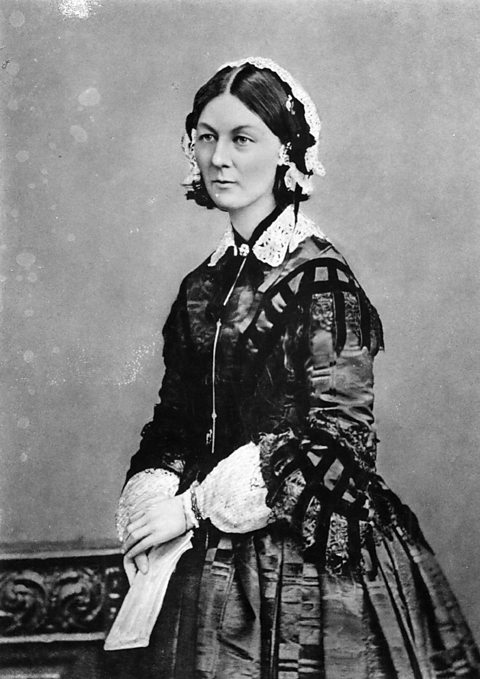The influence of Nightingale, Cadwaladr and Seacole on nursing
The 19th century saw a revolution in patient care. The role of the nurse became professionalised and hospital conditions began to be improved.
Conditions in early 19th-century hospitals
Though there was growth in the number of hospitals in the early 19th century, conditions for patients were generally poor. Wards were often cramped and rarely cleaned, so infection spread rapidly.
Nurses were untrained and nursing was looked upon as a job for uneducated women. In the early 19th century, nurses had a reputation for drunkenness. Charles DickensÔÇÖ description of the nurse Mrs Gamp in his novel Martin Chuzzlewit would have been familiar to many of his readers:
She was a fat old woman, this Mrs Gamp, with a husky voice and a moist eye ÔÇŽ She wore a very rusty black gown, rather the worse for snuff, and a shawl and bonnet to correspond ÔÇŽ The face of Mrs Gamp - the nose in particular - was somewhat red and swollen, and it was difficult to enjoy her society without becoming conscious of a smell of spirits.
Nursing was not seen as an occupation for respectable women. It would take a determined individual like Florence Nightingale to change popular opinion.
Florence Nightingale and the hospital at Scutari
Florence Nightingale came from a wealthy family. In 1851, against her familyÔÇÖs wishes, she went to Germany to study as a nurse. In 1854, when war broke out against Russia, she went to Crimea to care for wounded soldiers.

More British soldiers were dying from disease than being killed in battle. There were delays in transporting wounded soldiers from the battlefield due to a lack of stretcher-bearers and space on ships to transport them. As a result, many soldiers died before they got to a hospital. Those that reached a hospital were very ill when they arrived. Many were suffering from infectious diseases like typhusA bacterial infection spread by lice or fleas that causes fever, headache and a rash. dysenteryAn infection spread in contaminated water. Symptoms include stomach pain and diarrhoea, both of which lead to extreme dehydration. and choleraA bacterial infection caused by contaminated drinking water. Those who had been operated on were in danger of dying from their wounds becoming infected.
Nightingale worked at the hospital at Scutari, Turkey. It was overcrowded and had been built on top of a sewer that regularly flooded. Nightingale found that the conditions were appalling and began to change them for the better:
- Patients were separated according to their illness.
- Beds were spaced apart and clean air was allowed to circulate.
- Strict hygiene rules were enforced, eg patients were washed and bedding was changed regularly.
In just six months, Nightingale managed to reduce the death rate significantly. To soldiers she was known as the Lady with the Lamp as she would patrol the wards, carrying a lamp so she could check on her patients throughout the night.
Nightingale received press coverage by journalists such as William Howard Russell, who wrote in the London Times. This not only made her famous but also highlighted the need for hospital reform. Under a lot of public pressure, Sidney Herbert, Secretary of State at War, gave his support to a scheme to improve military hospitals.
Florence NightingaleÔÇÖs influence on nursing and hospital design
When she returned to Britain in 1856, Nightingale set about transforming nursing. Instead of being just cleaners and minders, nurses were trained to be an essential part of patient care:
- With money raised from public donations, Nightingale set up the first training school for nurses, putting into practice the ideas she had developed in Crimea.
- In 1859, she published a book,Notes for Nursing, which was a bestseller.
- She was often consulted about the design of new hospitals, which she said should include ÔÇťthe proper use of fresh air, light, warmth, cleanliness, quiet and the proper selection and administration of dietsÔÇŁ.
Nightingale made nursing a respectable profession. She also brought about significant changes in cleanliness and patient care in hospitals.
Betsi Cadwaladr
Like Florence Nightingale, Betsi Cadwaladr nursed British troops in Crimea. Cadwaladr trained as a nurse and in 1854, at the age of 65, went to Crimea. She did not get on with Nightingale, who she thought put too much emphasis on regulations and not enough on compassion for the injured.
After moving from Scutari to Balaklava, Crimea, Cadwaladr was known for the long hours she worked and her insistence on keeping wounds clean. She also tried to remove rules that stopped nurses from doing their jobs. She hated the levels of bureaucracy in the British military hospitals.
She caught cholera and returned to Britain because of ill health in 1855, and died in 1860. One of the four health boards in Wales is named after her in recognition of her work.
Mary Seacole
Another nurse who made her mark in Crimea was Mary Seacole. She used her own money to travel from Jamaica to Crimea, where she cared for injured soldiers from both sides of the conflict on the battlefield.
She also established the British Hotel near Balaklava to provide a mess table and comfortable quarters for sick officers and officers who were recovering their health and strength. She became known as Mother Seacole.